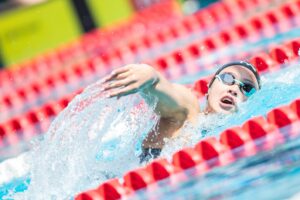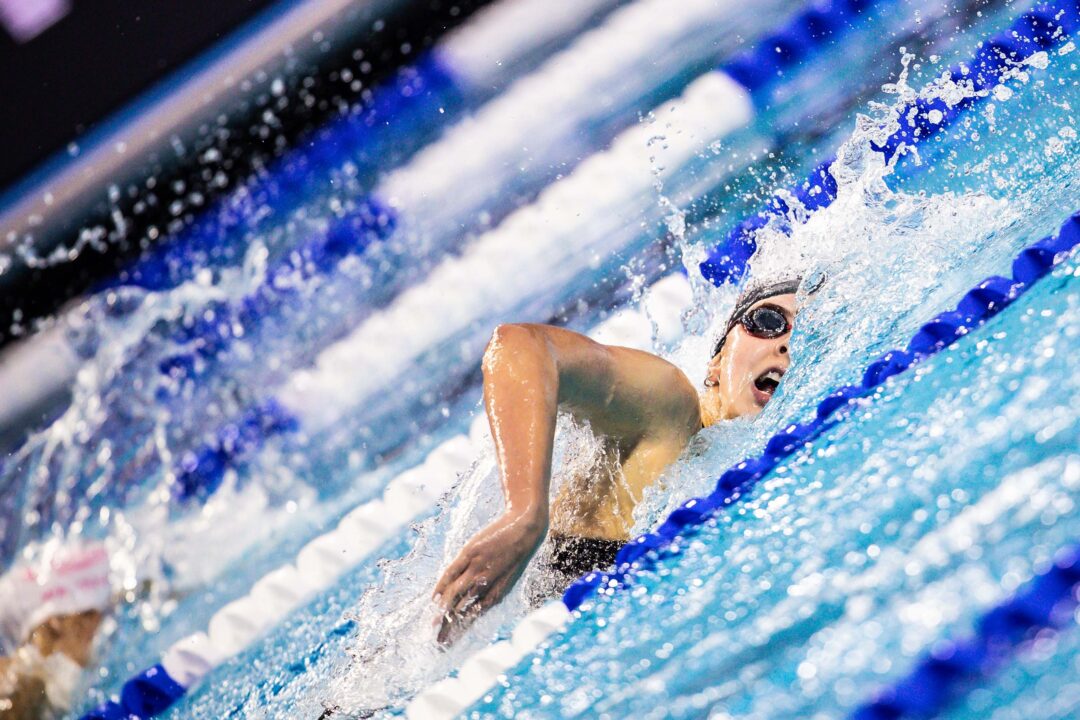Welcome to this edition of our weekly NCAA recap! Over the past week, there were almost too many midseason invites to count, with big swims coming from all over the country. So, to keep up with the midseason madness as much as possible, we’re changing up the structure of this week’s recap.
Up front, we’ll talk about some of the big themes that came out of this first weekend of midseason invitationals (why yes, I was raised by English teachers). Then, like we do for big national/international meets, we’ll check in on some of the swims you may have missed while goggling at what Gretchen Walsh did at the Tennessee Invite.
Related:
- Division III Round-Up: Derek Maas Breaks Out in Backstroke
- NCAA First-Year Head Coach Check In: Michigan, Duke Thriving Under New Leaders
Themes Of The Weekend
Women’s Distance Is Back
We talked about the resurgence of women’s distance swimming in the NCAA a couple weeks ago in these recaps, and we wrote about it again before day 2 finals of midseason invites, which is when the 500 free finals race. At that point, we already had 11 women under the 4:40 mark compared to three after last season’s invites.

Bella Sims (photo: Jack Spitser)
And day 2 finals across the country showed the swimmers had even more in store for us. At the Georgia Fall Invite, freshman Bella Sims and defending SEC champion Rachel Stege faced off–Sims won the close race (4:32.53) by .34 seconds as she and Stege established the top two times of this season. Stege’s 4:32.87 is a massive drop from her previous best of 4:36.31, swum at 2023 SECs.
And the list of women under 4:40 just kept getting longer. Six more women broke the barrier in finals, bringing this season’s total up to a whopping 17.
Sims, who SwimSwam writers unanimously picked to win the NCAA title in March, holds a lifetime best of 4:28.64. That’s markedly faster than the rest of the field, but even if she swims away for the win, this is still shaping up to be one of the most competitive fields we’ve seen for the 500 free in years.
It’s unrealistic to expect that each of these swimmers is going to perfectly hit their taper at NCAAs, but even so, it looks like the 8th-place time to qualify for the ‘A’ final will be under 4:40 for the first time since 2019. Even outside of the ‘A’ final, 17 women is more than the number of qualifiers. Having this many swimmers this fast already puts even more pressure on prelims. There’s another 5 women in the 4:40 range this season and it took 4:40.81 for a second swim in 2023. If you don’t get up and go in the morning, you could be in the 4:40 range and still be on the outside of finals.
ASU’s Depth Dominates
Léon Marchand only raced one individual event at the NC State Invite. But even the three-time World Champion’s absence didn’t blunt the dominance the ASU men displayed over the weekend in Greensboro. We haven’t seen Cal at their midseason invite yet, but it’s looking increasingly like they’re going to have to be perfect to beat ASU at NCAAs.
The Sun Devils have an incredibly complete team and they showed this weekend that yes, Marchand is an important piece of their plan, but they won’t collapse without him. They broke five school records, went five-for-five in relays, and won 11 individual events, going 1-2-3 in six of those events (500 free, 200 IM, 400 IM, 200 free, 100 back, 200 back).

Hubert Kos, courtesy Fabio Cetti
Hubert Kos led the way for them with four event wins. Kos, who joined the team in January 2023, won the 100/200 back and 200/400 IM with new personal bests in all four. His statement swim came on the final day in the 200 back when he dropped a blazing 1:36.54 that broke the program record and makes him the fastest all-time non-American performer in the 200-yard backstroke.
Ilya Kharun, Jonny Kulow, Owen McDonald and Jack Dolan also helped contribute to the Sun Devils’ depth this weekend. Kharun took back the program record in the 100 fly (44.33) and lowered his 200 fly program record–which he’s already broken again with a 1:38.11 (altitude-adjusted). He also broke 19 seconds in the 50 free for the first time in his career (18.93). Kulow took out the 100 free program record with a 41.44; he and Kharun also teamed with Dolan and Cam Peel for a new program record in the 200 freestyle (1:14.64).
Their relays have been impressive all season, but they took them to another level this weekend. The Sun Devils lead the NCAA in four of the five possibly relays (Texas has the #1 spot in the 800 free relay). Not only that but in the 200 free, 200 medley, and 400 medley relays, they lead the rest of the NCAA by over a second.
Texas Women Keep Flying
The Longhorn women lost a key part of their fly group with Dakota Luther‘s graduation. But they haven’t missed a step and have even begun dominating the 100 fly in addition to the 200 fly. Defending NCAA champion Emma Sticklen and fifth-year Kelly Pash own the top two 200 fly times this season, courtesy of their 1:50.31 and 1:52.17 from the Texas Hall of Fame Invite.

Kelly Pash (photo: Jack Spitser)
But the real story for them is in the 100 fly. Earlier in the meet, they swept the top four spots. At the touch, Sticklen got the better of Pash by .01, 50.36 to 50.37, and Olivia Bray followed closely just a tenth behind. That gives them the 2nd, 3rd, and 4th places in the NCAA this season. Plus, Ava Longi sits in 7th with a huge personal best 51.39.
Longi and Pash’s new personal bests signal an opportunity for Texas. Only three of the 2023 ‘A’ finalists return in the event. Pash’s new best of 50.37 would easily qualify her for the ‘A’ final and stacks up nicely against the returners in the field. It also gets Pash out of dealing with a 200 freestyle field that’s getting increasingly competitive. Even without being sure what G. Walsh is going to swim on day 3, the 100 fly currently looks a safer bet for Pash to make the ‘A’ final in.
Swims You May Have Missed
Women
- Aurora Roghair, Stanford — Aurora Roghair swam a personal best in every individual race she swam at the Texas Hall of Fame Invite. Her times in the 200 free (1:44.10), 500 free (4:37.10), and 1650 free (15:52.83) would have all landed her in scoring position at 2023 NCAAs, which she missed last year. Her swim in the mile marked her first time breaking 16 minutes. For the rebuilding Stanford Cardinal, it’s exactly the right time for her to be breaking out.
- Paige MacEachern, UCLA — Junior Paige MacEachern shaved two-hundredths off her 400 IM personal best to win at the Art Adamson Invite. It’s over three seconds faster than she was at midseason last year. MacEachern finished 15th at NCAAs last year and if she can hit this time at the big meet, she could upgrade into the ‘A’ final. In addition, MacEachern won the 200 IM by breaking 2:00 for the first time with a 1:57.20, then swam another personal best in the 200 fly (1:57.08).
Men
- Brian Benzing, Towson — Senior Brian Benzing had a great weekend at the Patriot Invitational. He’s a dark horse in the wide open race for the NCAA title in March. He turned in a 51.48–.89 seconds faster than he was at the meet last year–which ranks him #3 in the NCAA this season. But his excellent meet went beyond his speciality event. He swam PBs in the 50 free (19.90), 200 breast (1:54.64), 100 fly (46.21), and 200 IM (1:43.66).
- Aidan Stoffle, Auburn — Aidan Stoffle, the elder of the two Stoffle brothers, had an excellent weekend at the Georgia Invite. He’s more of a 200 back specialist–he won the 200 backstroke ‘B’ final at 2023 NCAAs–but he had a breakout in the 100 back last weekend by breaking 45 seconds for the first time. He also went a personal best in the 200 back, hitting a 1:38.57 for 2nd place. Both those swims would’ve landed him in their respective ‘A’ finals at 2023 NCAAs. Auburn only had one ‘A’ finalist in Minneapolis, and they’ll need more if they want to hold onto their top-10 finish against surging teams like Notre Dame and Texas A&M.

NoNE oF ThIs mAttErs UnTIl MaRch…/s
Cal needs to register for some swim meets!!
I commented last week that it would take faster than the women’s 500 winning time from last year (4:36) to make the A final this year at NCAAs. I got a lot of downvotes. I re-upping that prediction especially after seeing the GA Invite results.
I could see 8 women hitting that time at NCs, but I don’t think it will happen in the morning.
Because women can’t or won’t go nuts in the prelims like the men?
conceivable but unlikely
Wait did Kharun go 1:38 in the 2-fly?!?! Or is that a typo? Maybe 1:39.11?
It’s the altitude converted time
Justin — ASU stopped at Utah for a dual meet on the way home from North Carolina; Elevation 4783; after swimming 1:39.10 winning the NCState Fall Invite at GAC, he swam 1:39.31 at 4783 feet elevation, which was altitude adjusted to 1:38.11, per SwimCloud rankings.
Also in the Utah meet he brought his 3rd event choice into question again, even after going :18.93(#6) in the 50 in the GAC meet. Entering the Utah meet with a 200 IM PB of 1:45.93 from the ASU-USC dual last month, Ilya swam the 200 IM in 1:43.51, producing an altitude adjusted 1:42.31, SwimCloud, which moved him into #8 — one slot ahead of some guy named Marchand, who was apparently too ill… Read more »
Has there been any actual scientific/mathematical explanation behind those altitude conversions? They seem somewhat…not accurate…given how “clean” they are (and how at certain levels, you don’t see swimmers match those times at sea level…)
500 for women’s is back on the right trajectory!
Has anyone seen an explanation of missing NCST men, Bustos, Hayes, Kacper, etc?
Bustos swam, he just didn’t do all his primary events – a lot of the NC St guys did the same thing. Now Hayes and Stokowski I have no idea, since they weren’t around a couple weeks ago either.
Hayes and Stokowski were at the invite training. I assume most the guys were getting ready for the US Open
Hayes and Stokowski both in US Open psych sheets
NC state is cursed and they can’t have anything nice is the only logical explanation here
More Andrew hate.
When did Kharun go 1:38.11?
It’s the altitude conversion of his 1:39.31 at Utah.
Is altitude conversion a “real thing”…..as in official? Or is it just a conversion for discussion? Would a kid who gets his first Olympic Trial cut at altitude be granted entry into the meet with an official conversion or is it just something used for time comparison?
Altitude conversions are allowed for Olympic Trials cuts and NCAA qualifications.
Very cool. Thanks.
Ava Longi is a senior.
this